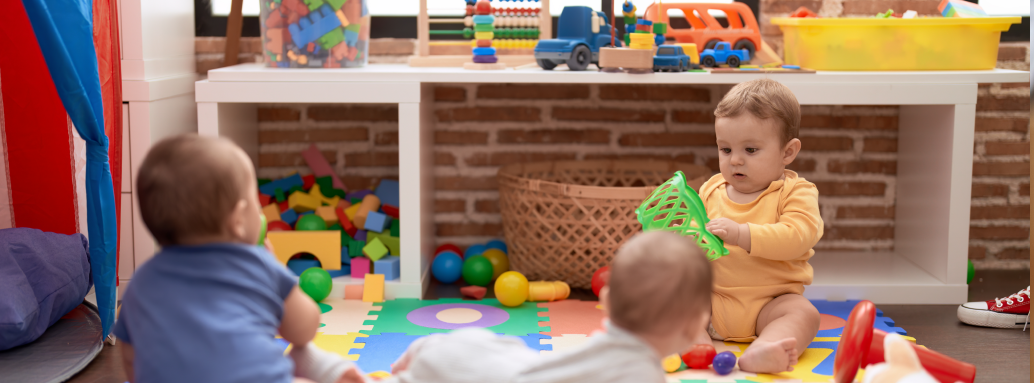In the captivating journey of early childhood development, providing a secure and nurturing environment lays the groundwork for a flourishing future. The formative years from infancy to toddlerhood are a critical phase of growth, and crafting a haven that addresses their physical, emotional, and cognitive needs is paramount.
In the early stages of life, children are sponges, absorbing every experience, emotion, and interaction. How can we, as parents, caregivers, or educators, create an environment that is not only safe but also nurturing for infants and toddlers? As we delve into the art of creating such an environment, we'll explore strategies that not only prioritize safety but also promote holistic development.
Understanding Infants and Toddlers
Infants, those delicate beings in their first year of life, are in a rapid phase of growth and exploration. Their tiny bodies and boundless curiosity make them eager learners through their senses. On the other hand, toddlers, the spirited explorers aged 1 to 3, are entering a phase of more intentional interactions with their surroundings. This dual perspective guides our approach to nurturing.
Age Group Needs
Infants (0-12 months)
- Importance of Safety: Infants require constant attention and care. Ensuring physical safety involves baby-proofing the house, using safety gates, and keeping small objects out of reach.
- Importance of Nurturing: Nurturing at this stage includes loving touch, soft-spoken words, and gentle play. It forms the cornerstone of emotional development.
Toddlers (1-3 years)
- Importance of Safety: As toddlers begin to explore, safety measures need to adapt. Locking cabinets, anchoring furniture, and close supervision become essential.
- Importance of Nurturing: Nurturing for toddlers includes encouragement, positive reinforcement, and guided learning. They thrive on routine and familiar faces.
Safety as the Foundation
At the heart of a nurturing environment lies safety. Before an infant's tentative grasp or a toddler's daring steps, the environment must be childproofed. This means securing sharp edges, covering outlets, and eliminating choking hazards. A pristine environment free from germs is equally vital, as infants and toddlers tend to explore with their mouths.
Creating Emotional Security
Emotional security is the cornerstone of early development. Responsive caregiving, where a baby's cries are met with comforting arms, builds a sense of trust. Consistency in response forms the scaffold of reliability in a child's mind, fostering a safe haven even in uncertain situations.
- Emotional Safety Pro Tip: Emotional safety ensures a child feels secure, loved, and understood.
Stimulating Cognitive Development
To stimulate budding cognitive abilities, age-appropriate toys and activities play a pivotal role. Bright colors, textures, and sounds engage their senses. As toddlers evolve into curious explorers, providing safe objects for stacking, sorting, and pretend play aids in cognitive growth.
- Mental Safety Pro Tip: Cognitive and mental safety includes providing stimulating yet non-overwhelming experiences.
Promoting Physical Development
Physical development blossoms through movement. For infants, tummy time is essential for building neck and upper body strength. Toddlers benefit from spaces that encourage crawling, walking, and climbing. Aided by their inquisitive nature, they conquer physical milestones with determination.
- Physical Safety Pro Tip: Creating physical safety includes eliminating potential hazards and creating boundaries.
Effective Communication and Language Nurturing
Words are windows to a child's understanding. Infants love the sound of their caregivers' voices, absorbing language like sponges. Reading to them ignites a love for words and storytelling. For toddlers, conversation becomes a tool for expression and comprehension, laying the foundation for language skills.
- Screen Time: Moderation in screen time and appropriate content is key.
- Educational Apps: These can aid in learning if used sparingly and wisely.
Healthy Sleep Routines
Sleep is the reset button for young minds. Creating a soothing bedtime routine signals the transition to rest. A cozy sleep environment, complete with soft bedding and a dim nightlight, cultivates a sense of security and comfort.
- Importance of Sleep: Regular sleep schedules ensure healthy development and emotional stability.
- Creating Routine: Bedtime routines provide comfort and ease the transition to sleep.
Balanced Nutrition and Feeding Practices
Nutrition takes center stage as infants transition to solids and toddlers become independent eaters. Introducing a variety of foods and textures fuels their growing bodies and curious palates. Staying hydrated is equally crucial.
- Physical Nurturing: This involves warm hugs, holding hands, and bodily care like feeding and bathing.
- Emotional Nurturing: Emotions must be acknowledged and understood to foster emotional intelligence.
- Educational Nurturing: This includes reading, singing, and encouraging curiosity.
Social Interaction and Play
Play is the language of childhood. Social interactions with peers teach valuable lessons in sharing, empathy, and cooperation. Unstructured playtime nurtures creativity and problem-solving skills, building the foundation for future relationships.
- Age-Appropriate Toys: Choosing toys that are suitable for their age ensures safe and stimulating play.
- Stimulating Creativity: Creative play such as drawing, building, or role-playing fosters mental growth.
Managing Separation Anxiety
Separation anxiety is a natural part of development. Strategies like gradual separations, familiar objects, and consistent routines ease the transition. As they venture into group settings, the secure environment you've built serves as their anchor.
Positive Discipline and Boundaries
Discipline, approached gently, sets the stage for understanding boundaries. Toddlers learn through exploration, often pushing limits. Redirecting their attention and calmly explaining boundaries create a nurturing approach to discipline.
Involving Parents and Caregivers
Creating a nurturing environment requires a collaborative effort. Communicating with parents and caregivers ensures consistency between home and care settings. Sharing resources and offering support fosters a sense of community.
Parent Interaction
- Building Trust: Trust between child and parent is foundational for a secure attachment.
- Communication: Open communication, even with infants, fosters trust and understanding.
- Emotional Bonding: This goes beyond basic needs and creates a deep emotional connection.
Adapting the Environment as They Grow
Infants evolve into toddlers at an astonishing pace. Adapting the environment to their changing needs is essential. From baby-proofing to creating spaces that encourage independent exploration, the environment grows with them.
Professional Care
- Selecting Care Providers: Choosing the right caregivers includes checking credentials and safety standards.
- Safety Standards: Professional care must adhere to local regulations and laws.
Healthy Eating
- Diet for Infants: Breastmilk or formula, followed by a slow introduction of solids, ensures proper nutrition.
- Diet for Toddlers: A balanced diet with whole grains, fruits, vegetables, and proteins fosters growth.
Conclusion
The journey from infancy to toddlerhood is a remarkable one, and the environment plays an influential role. By crafting a safe, nurturing haven, caregivers and educators lay the groundwork for a future filled with curiosity, resilience, and confidence. As we dedicate ourselves to providing infants and toddlers with the best possible start, we gift them a lifetime of positive experiences and boundless potential.
Creating a safe and nurturing environment for infants and toddlers requires understanding, empathy, and practical knowledge. By implementing these strategies, you're building the foundation for a thriving and joyful childhood.
FAQs
-
When should I start childproofing my home for an infant? Childproofing should ideally begin before the infant starts moving, usually around 6-8 months.
-
What's the importance of reading to infants? Reading to infants exposes them to language, rhythm, and storytelling, nurturing their cognitive and emotional development.
-
How can I ease separation anxiety in my toddler? Gradual separations, consistent routines, and offering comfort items can help ease separation anxiety.
-
What are some age-appropriate toys for toddlers? Toys that encourage imaginative play, fine motor skills, and problem-solving, such as building blocks and shape sorters, are great choices.
-
Why is positive discipline important in early childhood? Positive discipline focuses on teaching and guiding rather than punishment, fostering a child's self-esteem and understanding of boundaries.
Billing, Invoicing Automation & Smart Finances
Communication & Engagement
Child Development & Progress
Waitlist, Forms & Attendance
Effortless Team Management
Daily Updates That Matter
Templates & Printables
Blogs
Webinars
Case Studies & Testimonials
FAQs
Help Center



